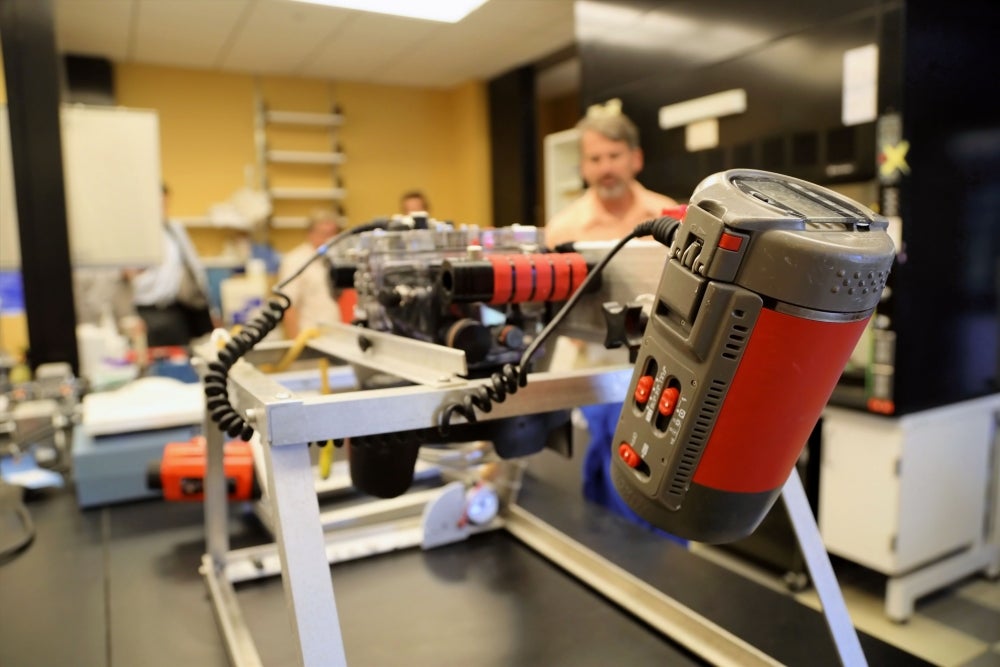One Giant Step for Ocean Biodiversity
With 13 scientific investigators and 10 partner institutions, the marine biodiversity observation network (BON) centered on the Santa Barbara Channel is the epitome of collaboration. Funded with $5 million by NASA, the Bureau of Ocean Energy Management (BOEM) and the National Oceanic and Atmospheric Administration (NOAA), the UC Santa Barbara-led project officially kicked off Thursday, Oct. 23, at UCSB’s Marine Science Institute (MSI).
“We’ve got principal investigators here from two colleges, a professional school, over six different department on campus, as well our friends at NOAA,” said MSI Director Mark Brzezinski. “It’s an incredibly interdisciplinary team ranging from biology to engineering, and it’s no small feat to bring that kind of group together. Here at UCSB, we really pride ourselves on this kind of interdisciplinary work. It’s our normal mode of operation.”
Designed to fill a gap not addressed by NASA’s Group on Earth Observations (GEO) BON, which focuses on terrestrial biomes, this prototype marine BON seeks to eventually cover a huge range of biodiversity in the oceans. The effort begins in the Santa Barbara Channel where various groups have been gathering a breadth of scientific data ranging from intertidal monitoring to physical oceanographic measurements.
“There have been a huge number of observations taken over time in the channel,” said Robert Miller, a research biologist with MSI and a principal investigator of the marine BON. “The channel has also been a hotspot for remote sensing research, which gives us a wider picture of the area, which we can then match with in-situ observations.”
The marine BON has three goals: to integrate biodiversity data to enable inferences about regional biodiversity; to develop advanced methods in optical and acoustic imaging and to improve monitoring biodiversity in partnership with ongoing monitoring and research programs; and implement a tradeoff framework that optimizes allocation of sampling effort, given the cost of that effort and the information gained from it.
“Existing diversity data streams will be augmented with new technology and compiled into a comprehensive dataset on species richness,” Miller said. “Richness data will be distilled to create synthetic indices of diversity and ecosystem health, and geospatial modeling will be used to interpolate these data across space.”
Ultimately, the body of knowledge amassed by the prototype marine BON will mesh with essential biodiversity variables (EBVs), the metrics adopted by NASA’s GEO BON to measure biodiversity across the Earth. In this way, the measurements generated through the marine BON may one day be part of a global assessment of biodiversity.
The day’s activities continued with tours of various UC Santa Barbara labs involved in the marine BON project, as well as seminars given by Gary Geller, deputy manager of the NASA Applied Sciences Ecological Forecasting Program, and William Y. Brown, chief environmental officer of BOEM.
Brown was invited by UCSB’s Bren School of Environmental Science & Management to speak about BOEM’s offshore energy mission and discuss how the agency’s Office of Environmental Programs is integrated into bureau program activities to meet its environmental stewardship responsibilities. BOEM’s mandate is to manage the development of the nation’s offshore resources in an environmentally and economically responsible way. Brown also addressed the bureau’s Pacific environmental studies related to scientific assessment and environmental monitoring both offshore and in coastal environments as well as careers related to ocean science.
Other UCSB investigators involved in the project are Craig Carlson, chair of the Department of Ecology, Evolution and Marine Biology (EEMB); Deborah Iglesias-Rodriguez, an EEMB professor; Phaedon Kyriakidis, a professor in the Department of Geography; Kevin Lafferty, a principal investigator with MSI and a marine ecologist with the United States Geological Survey’s Western Ecological Research Center; Milton Love and Daniel Reed, research biologists with MSI; Douglas McCauley, an assistant professor in EEMB; B.S. Manjunath, director of UCSB’s Center for Bio-Image Informatics; Andrew Rassweiler, an assistant research biologist at MSI; and David Siegel, director of the Earth Research Institute. Additional investigators include Andrew Thompson of NOAA’s Southwest Fisheries Science Center.




